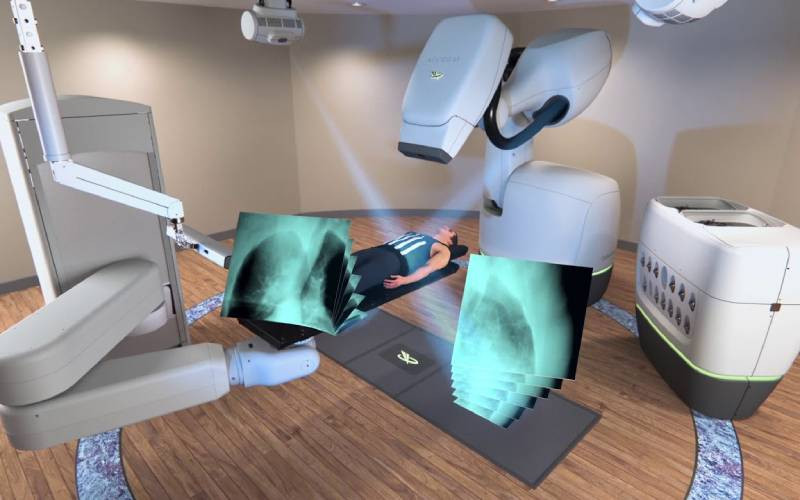
Kenya is celebrating another medical milestone this week.
The Kenyatta University Teaching, Referral and Research Hospital (KUTRRH) treated its first patient through the cyberknife procedure on Wednesday, September 27, the first of its kind in the country and Sub-Saharan region.
The journey to undertaking the procedure on the first patient came a long way after President William Ruto commissioned the machine in the facility in April this year.
But, what exactly does the procedure entail and what is it?
A CyberKnife is a non-surgical way to deliver high-dose radiation to cancerous or non-cancerous tumors accurately without damaging healthy tissues surrounding the tumor.
The radiation delivery system functions by using a linear accelerator directly mounted on a robot to deliver high-energy X-rays that help to accurately spot the tumor cells.
Once the patient is laid on a treatment couch, the machine uses its flexible robotic arm to move and bend around to spot various parts of the body where the tumor has grown.
- AstraZeneca launches care programme in latest war against cancer
- Better reporting in health centres aids cervical cancer data access
- Despite being treatable and preventable, cervical cancer still a nightmare for women
- CS Nakhumicha outlines Ministry's efforts to combat cervical cancer
Keep Reading
The robotic design, coupled with real-time imaging, enables the CyberKnife System to deliver ablative doses of radiation directly to the tumor from several beams of angles.
Radiation therapy is often used to treat different types of tumors in the body but with the machine's precise and accurate qualities, it delivers radiation to the tumor killing the cancerous cells while minimizing the dose to healthy tissues.
Types of tumors the procedure can treat
CyberKnife can treat both cancerous and non-cancerous tumors located on sensitive body organs including; the brain, liver, lung, pancreas, head neck, and spinal cord among other tumors.
It can also treat non-cancerous conditions like Trigeminal Neuralgia and specific non-cancerous pancreatic lesions.
Certain functional disorders can also be treated like epilepsy by targeting specific brain areas responsible for seizures.
Benefits of cyberknife procedureThe procedure has many benefits compared to the other methods initially used to get rid of tumors in the body cells.
One of the benefits is that a patient undergoing the procedure doesn't have to be injected with anesthesia because it is a non-surgical procedure.
The treatment can be performed on an outpatient basis with each treatment lasting between 30 to 90 minutes hence speedy recovery.
Movement of the tumor during treatment caused by coughing, breathing, or swallowing does not alter precision since the machine automatically adjusts the radiation beams accordingly.
It has few side effects because the precision treatment ensures that surrounding healthy tissues are not damaged hence few health complications.
The CyberKnife treatment is delivered in three to six outpatient sessions compared to traditional radiation therapy, which requires 20 to 30 sessions to complete treatment.
The number of treatment sessions varies depending on the size, location, and shape of the tumor.
In Kenya, NHIF insurance is accepted for such treatment, and an average of Sh300,000- Sh350,000 fee for other insurance companies which will make it easier for patients to access the services.
Kenya now becomes the first country in sub-Sahara Africa to acquire the CyberKnife system.
 The Standard Group Plc is a multi-media organization with investments in media platforms spanning newspaper print
operations, television, radio broadcasting, digital and online services. The Standard Group is recognized as a
leading multi-media house in Kenya with a key influence in matters of national and international interest.
The Standard Group Plc is a multi-media organization with investments in media platforms spanning newspaper print
operations, television, radio broadcasting, digital and online services. The Standard Group is recognized as a
leading multi-media house in Kenya with a key influence in matters of national and international interest.











